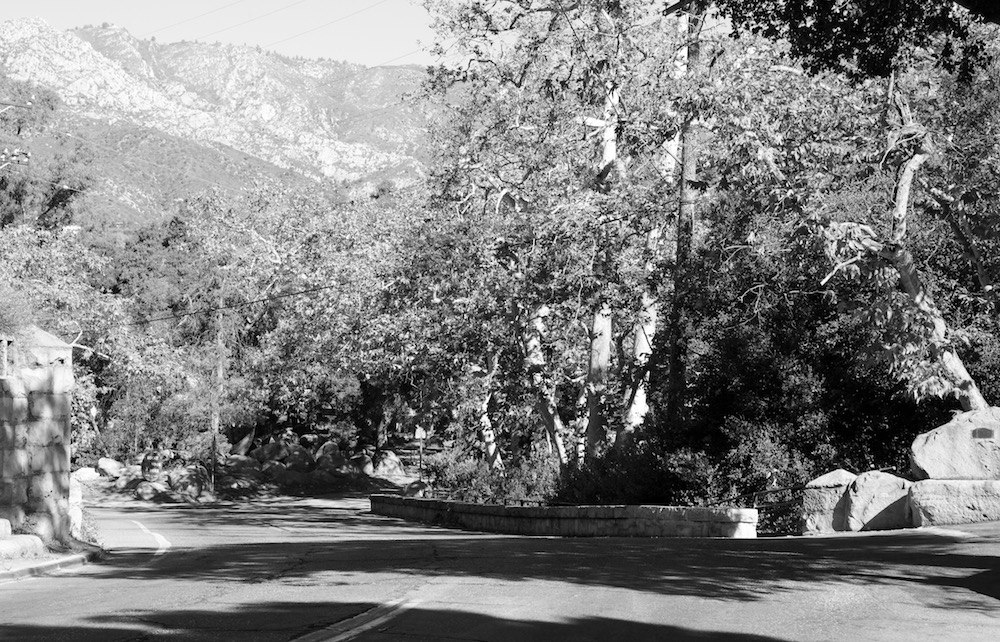The Enduring Spirit of Rocky Nook
Santa Barbara Landmark Up for Historic Designation

Traveling uphill from the coast, the visitor comes to the grand view of the Santa Barbara Mission, a historic landmark, but the turn in the road that follows has a very different atmosphere. On its way up Mission Canyon, the road leads into a more intimate and rural landscape created by the forces of nature and careful planning of the earliest settlers. It is a unique and inspirational surprise, one that is being considered for Santa Barbara County Historic Landmark status.
An unusual feature at the edge of Rocky Nook Park is a watering trough for horses. It was a gift from Frances Dabney Oliver in memory of her deceased husband, George Oliver, and an expression of their affection for Mission Cañon. Huge, character-defining boulders echo the landscape. This historic vista of stone bridge, majestic sycamore trees, and native vegetation along the road marks the entry to the property in the earliest photographs. The Oliver trough (1910) and Mission Creek bridge (1890) are both Historic Landmarks. The spatial relationships and surrounding landscape features at the entry are significant elements of this beautiful site. Original curbstones and ancient outcroppings also remain.
Chumash oral narratives describe the event of 1,000 years ago when a great flood brought tons of mud and boulders down the canyon leaving deep piles of rocks on the land. This catastrophic debris flow created the landscape in Mission Canyon and Rocky Nook Park. The natural meandering stream with riparian habitat and oak woodland supplied what the ancient village of Xana’yan needed for sustenance and enjoyment. These resources are still in the park and provide a natural and profound educational experience.
The Europeans, starting in 1782, used the water and construction materials found in Rocky Nook for the founding of the Presidio and the establishment of the Old Mission in 1786. Original 1806 aqueduct sites built with Chumash labor exist in the park. The City of Santa Barbara depended on this water source well into modern times. Our distinctive stonewalls and architectural features are a result of the abundance of natural materials found here.
In 1881, after retiring from diplomatic service in the Azores, the Olivers settled in the cañon. The cottage on the property was previously occupied by a member of the locally prominent De la Guerra family. President Thomas Jefferson had appointed Frances Dabney Oliver’s grandfather U.S. consul to Azores, Portugal, and her father and brother served in the same capacity. George Oliver served as U.S. vice consul and as German consul.
“Fanny” became famous for her naturalistic gardens. She mingled Mediterranean and native plants among the boulders and was an early proponent of water conservation. Rare trees planted by the Olivers are now giant specimens in Rocky Nook Park. As a patron of the arts, Fanny donated to the building of the Lobero Theatre in 1924. Significant character-defining features of the site are the retaining walls they had built along the creek to hold back the raging waters during storms.
After her passing, a group of her friends and neighbors, who were also influential and leading citizens of the day, raised the funds to purchase the main portion of her property and establish a park for the public in Frances Oliver’s honor, keeping the name she had given it, Rocky Nook.
Rocky Nook Park was established in 1928, and it was left as natural as possible. Trails were already there from the Olivers’ time and earlier. Historic dirt trails and winding roads in Mission Canyon likely follow original Chumash routes.
A cottage for caretakers, with guidance from the Community Arts Association, was built in the Spanish style becoming popular after the 1925 earthquake and to complement the nearby Woman’s Club. A portion of the historic adobe foundation from the original cottage from the Mission period was saved. The first caretakers in the park were Californios and descendants of Presidio soldiers.
The County Parks department and park rangers provide this sylvan oasis for our enjoyment at the doorstep to the city. Generations have cherished the semi-rural way to travel between points in the city and into the canyons. Rocky Nook Park contributes to the aesthetics and significance of the historic area of Mission Canyon and is a significant cultural landscape that lifts our spirits and connects us to the past.
Rocky Nook Park has been nominated for Santa Barbara County Historic Landmark status, and while the commission is in favor of the nomination, letters of support are appreciated. Send letters to the Santa Barbara County Historic Landmarks Advisory Commission, dvillalo@co.santa-barbara.ca.us.



